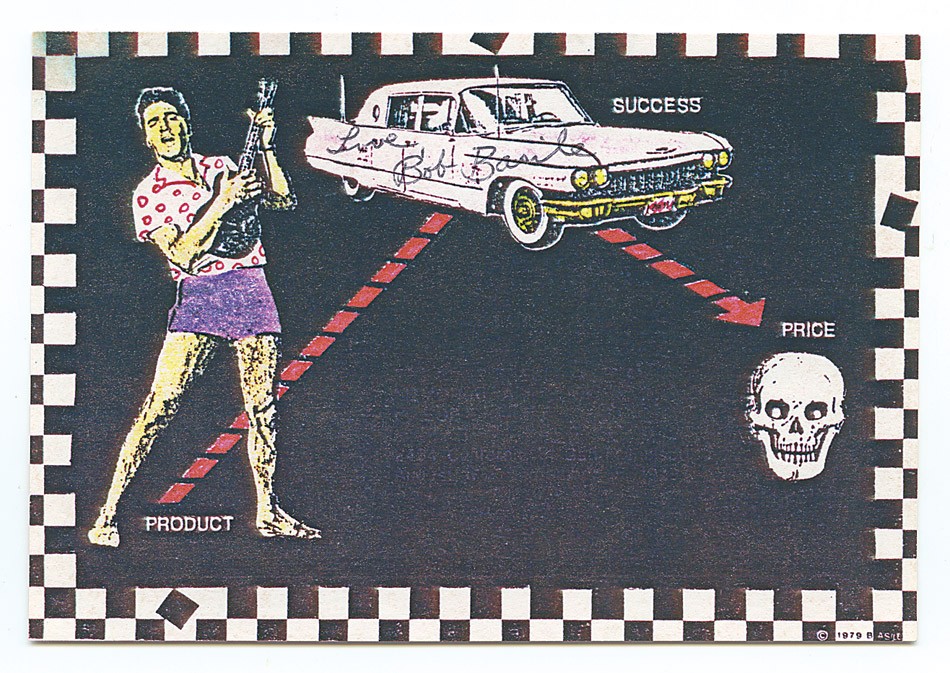You may be familiar with how the story of photography, westward expansion, and the growth of the Hollywood film industry are all tied up in the history of Eastman Kodak, but another Rochester company was integral in the development of West Coast arts movements as well. The fascinating current exhibit at Brockport's Tower Fine Arts Gallery explores a niche slice of artmaking that arose from the use of Xerox photocopiers.
"The Immovable Camera" was put together by artist, curator, and author Robert Hirsch; Brockport Associate Professor of Art Kitty Hubbard; Ray Brewer, a mechanical engineer who manages the Xerox Historical archives; and Tom Carpenter, who is an artist and visual art teacher at Monroe 2 BOCES at West Side Academy. The show highlights a collection of artwork donated to the Xerox Historical Archives from the estate of Barbara Cushman, a prominent figure in the San Francisco Bay copy art scene.

- PHOTO PROVIDED
- A postcard from "The Immovable Camera" exhibit, which showcases art made with Xerox photocopiers. The show is on view at Tower Fine Arts Gallery through December 11.
"From its inception, the art of photography required imagemakers to bring their cameras to the subject matter," the curators explain in a provided statement. But the release of the Xerox 6500 color copier in 1973 transformed that premise. Subject matter could now be brought to the "immovable camera" at a copy center, where artists worked with trained operators to create calendars, mail art, and self-published zines.
"Affordable, on-demand color printing gave individuals from all walks of life the freedom to construct and circulate their own images, thus by-passing the conventional means of production, censorship, and circulation," the provided information says.
The machines used a different color palette than film, and the copier's limited depth of field altered how artists composed their work. "Experimentation was at the fore as there was no established aesthetic," the curators say. And the near-instantaneous results allowed quick conceptual and technical adjustments to be made, unlike the prolonged labor involved in the darkroom or print studio.
The genre of copier art overlaps with the fields of printmaking, photography, and collage. Some artists scanned 3D objects arranged into still-lives on the copier glass, while others copied images and objects, cut and pasted, rearranged and rescanned. The artists' ability to use absolutely anything creatively in surprisingly unique and diverse ways is truly showcased in this exhibit.
"The Immovable Camera" has a local connection not only because Xerox is a Rochester-based company, but also because the medium manifested on this coast.
Though the materials in the show are drawn from Cushing's collection of Bay Area art, some east coast artists are represented nevertheless. An exhibition catalog from "Electroworks," produced at Eastman Museum in 1980, includes a 1974 work by Rochester artist Joan Lyons that depicts a dreamy photocopied woman with her hair fanned outward.
Although the machines were developed with business applications in mind — posters of office gals demonstrating the use of the machines, an actual machine, as well as tools and color creation kits, are on display with the artwork — artists took advantage of this new, affordable way to create permanent color photographic prints without access to an expensive chemical darkroom or specialized training.
"A lot of the artists who worked at this time didn't have traditional arts education background, they were just artists who had these ideas and wanted to get them out there," Carpenter says.
Collectives formed around the availability and use of these office machines, and many of the calendars present in the show are a result of these collaborative efforts, with different artists creating pages for different months. Some wall text offers a testimony from Carrie Hesler, a.k.a. Carioca, who was part of the Bay Area scene. She describes how photocopying her collaged postcards brought her into the art scene fold, and the growth of the international mail art scene. Display cases and wall arrangements present some of these incredibly inspired postcards.
The tone of the show has a definite anti-establishment, punk-rock aesthetic, and though no actual zines are present, zine culture arose from the use of the photo copier as a tool for art making. Art reflected art as the year 1984 approached during the Reagan's tenure as President and the Cold War era kept charging. A heightened sense of doom manifested in sub-cultural imagery.
One wall of post cards clusters around a larger poster featuring Reagan, whose sunglasses reflect twin mushroom clouds as the date 1984 looms ominously above his head. A January 1984 calendar page is packed with camera lenses and ears pointed at a panicking man, with the phrase "Big Brother is watching you" below.
Elsewhere, imagery that looks like it was appropriated from Soviet propaganda posters is combined with pop cultural and commercial imagery, rounding out the artists' sarcastically dismal outlook.
It's easy to identify how these artists inspired and influenced artists working in other low brow fields of creation today — one work by Carioca full of theatrical red flourishes is very reminiscent of street art rock star Shepard Fairey's stickers and wheatpastes.